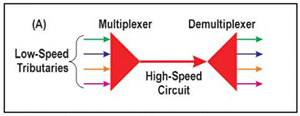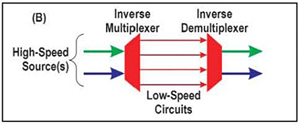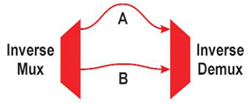The Advantages of Inverse Multiplexers

Multiplexers are used throughout television production. By combining several different signals into one stream, muxes are frequently deployed in satellite links, telecom circuits, and other applications where a single high-speed circuit is used to carry a number of low speed tributaries, as shown in Fig. 1a. At the far end of the circuit, a demultiplexer is used to separate the combined signals back into individual streams.
Inverse multiplexers, in contrast, perform the opposite function, by taking a single high-speed source signal and spreading it across multiple low-speed circuits, as shown in Fig. 1b. At the far end of the link, data from each of the individual low-speed circuits is extracted by the inverse demulitiplexer, and then combined to create the high-speed output. While not as common as multiplexers, inverse muxes can be quite useful in a number of situations.
INVERSE MUX USES
Inverse multiplexers are commonly used when a high bitrate signal needs to be delivered to a destination that is only accessible via low-speed circuits. This could occur, for example, at a remote broadcast site that is served only with telco lines that are limited to T1 (1.5 Mbps) service. This situation could also arise in a wireless application where each individual radio frequency may only support a low bandwidth signal, such as portable very-small aperture satellite systems that sacrifice bandwidth for portability and global coverage.

Fig. 1a: Combining several different signals into one stream, muxes are frequently deployed in satellite links, telecom circuits, and other applications where a single high-speed circuit is used to carry a number of low-speed tributaries. Economics is another justification for using inverse muxes, particularly in light of the circuit choices from many telephone companies. For example, a DS3 circuit with 45 Mbps of capacity is often priced four to five times higher than a T1 circuit with 1.5 Mbps of capacity over the same route, even though the DS3 has 30 times as much bandwidth. For a 10 or 20 Mbps service, the DS3 would obviously be the best solution. But, for a 3 to 4 Mbps service, a combination of two or three T1 circuits would be more economical.
Inverse muxes can also be used with different circuits to improve reliability and diversity. Some mobile data applications use multiple cellular phone data connections. In addition to providing more bandwidth, aggregating several wireless links can help compensate for gaps in coverage or overcrowded service areas. With a suitably provisioned inverse mux network, a failure of any single data path can be tolerated without disrupting the high-speed source stream.
Inverse multiplexes function by dividing a source signal into a number of individual streams, and reassembling it at the far end of the circuit. Thus, some method must be used to segment the source signal. When the source is an IP stream or a DVB/ASI stream, the data signal is already segmented into logical blocks, and this same grouping can be used to divide up the source signal. Alternatively, one or more source signals can simply be sliced into fixed length segments, which can be transported over the next available circuit.
Regardless of the segmentation method, framing overhead needs to be added to each of the low-speed signals to allow them to be properly reassembled at the far end of the circuit. This framing is essential to allow the individual streams to be identified and for their contents to be resynchronized to produce a stream that matches the source stream byte-for-byte. In some cases, this overhead can also include forward error correction (FEC) data that can be used to repair minor transmission errors.

Fig. 1b: Inverse multiplexers, in contrast, perform the opposite function, by taking a single high-speed source signal and spreading it across multiple low-speed circuits. One of the more difficult tasks for an inverse mux is to correct for the effects of differential delay. This occurs when one of the transmissions paths has a longer end-to-end transit time than another path. For example, as shown in Fig. 2, path A has a overall delay of 100 msec and path B has a delay of 83 msec. The differential delay between these two paths is 13 msec. The receiver must compensate for this difference by using a buffer on each component stream to match the delays on all the links to the delay of the worst-case link. Only once this has been accomplished can the inverse demultiplexer reassemble an exact copy of the source signal.
INVERSE MUX PERFORMANCE
Several different parameters are important when assessing the performance of an inverse mux:
Total Throughput is a measure of the total amount of bandwidth that can be processed by the inverse mux. Higher values indicate a system that can handle more traffic and higher-bandwidth source streams.
Overhead Percentage is the proportion of the signal framing and other overhead created by the inverse mux as compared to the overall bandwidth of the system. Lower values mean that more of the overall bandwidth is available for user data.
Maximum Differential Delay indicates the maximum size of the buffers that can be used to equalize the delay between the different component streams in the system. These values, usually expressed in milliseconds, are better when larger, indicating that the inverse mux can work on a wider variety of networks.
Overall Delay of an inverse mux system is equal to the sum of the delays within the inverse mux and the end-to-end transmission delay of the transmission circuits.

Fig. 2: One of the more difficult tasks for an inverse mux is to correct for the effects of differential delay. This occurs when one of the transmissions paths has a longer end-to-end transit time than another path.KEY INVERSE MUX FEATURES
Not all inverse multiplexers are the same. There are a variety of features which are present on some units and absent from others. When shopping for an inverse mux, consider the following:
Bandwidth Allocation, where the inverse mux is configured to set limits on the bandwidth of individual services. This allows operators to ensure that critical services are provisioned with all needed bandwidth, while allowing other services to consume any remaining bandwidth.
Automatic Configuration, where the inverse mux determines the number of connections present and configures bandwidth limits without requiring user intervention. On some systems, a cross-connection between different streams (say, output two on the mux being connected to input three on the demux) can also be automatically recognized and accommodated.
Failover Protection, where the inverse mux can identify a failed circuit and automatically route traffic over the remaining active circuits. This may also require a reduction in the bandwidth limits for variable-rate services. This feature is particularly valuable if the “active” and “protect” circuits do not need to be pre-identified, so that any circuit can spontaneously act in either role.
Support for Multiple Signal Types, where the inverse mux can concurrently transport a variety of signals, including fixed-rate and variable-rate services. A good example of this is an inverse mux that transports an ASI stream over a dedicated amount of bandwidth, and also supports an IP connection that occupies the remaining bandwidth. Provided that the bandwidth limits are set correctly, this configuration can deliver highly reliable ASI transport along with opportunistic IP data.
Bidirectionality, where the inverse mux is able to support signal flows in two directions simultaneously.
Selectable Error Correction, where the inverse mux supports a forward error correction scheme, which can be enable or disabled.
When properly specified and configured, inverse multiplexes can provide very reliable point-to-point communication systems.
Wes Simpson is an independent consultant and proud-co-author of the second edition of “IPTV and Internet Video,” which has just been published. He would like to thank Pete Gilchriest of ARG ElectroDesign for technical assistance with this column.
Get the TV Tech Newsletter
The professional video industry's #1 source for news, trends and product and tech information. Sign up below.
Wes Simpson is President of Telecom Product Consulting, an independent consulting firm that focuses on video and telecommunications products. He has 30 years experience in the design, development and marketing of products for telecommunication applications. He is a frequent speaker at industry events such as IBC, NAB and VidTrans and is author of the book Video Over IP and a frequent contributor to TV Tech. Wes is a founding member of the Video Services Forum.

